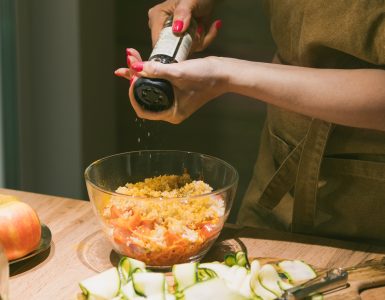In honor of today being National Celiac Awareness Day, we thought we’d talk a little bit about gluten. Gluten is the sticky protein found in wheat. It’s found in many grains, cereals, breads, and more. Gluten is present in many food products and other products that people frequently use. Those who suffer from Celiac Disease, and also those who suffer from gluten intolerances, have to avoid eating or ingesting products that contain gluten. Besides foods, some alcoholic beverages, medications, and beauty and skincare products contain gluten.
According to Celiac.com, you might suspect a gluten intolerance or Celiac disease if you have general gastric complaints, like intermittent diarrhea, abdominal pain and bloating. But many of these symptoms also mimic those of other diseases like Crohn’s or anemia. Also, some people who suffer from a gluten intolerance or Celiac disease don’t have any symptoms at all. If you suspect that you may have a gluten intolerance or Celiac disease, it’s important that you talk to your doctor, who can evaluate your symptoms and determine if you should be tested for these conditions. Since Celiac disease can cause malabsorption of nutrients, it is important that you get diagnosed so you can modify your diet to exclude glutenous foods.
So where exactly is gluten found?
- Some obvious places… Gluten is found in wheat, barley, malt, and rye; it can also be found in oats.
- Some less obvious places… Gluten can often (although not always) be found in sauces (including soy sauce) and gravies, salad dressings, processed meats and cold cuts, soups, and ice creams. Glutenous ingredients are often used to thicken these products. If you are gluten-free and would like to eat one of these products, always be sure to read the label carefully to ensure the product is free of anything glutenous. Click here for celiac.com’s comprehensive list of unsafe and potentially unsafe ingredients for people who must avoid gluten; Allergic Living also has a detailed list of potentially glutenous products.
- Read food labels carefully. Before, you may never have had a reason to understand what substances like hydrolyzed vegetable protein, modified food starch, dextrin, natural and/or artificial flavorings, or things labeled as “extracts” are. These mysterious-sounding ingredients–depending on where they were made–may contain gluten.
- It’s not just in food… If you must avoid gluten, beer is off-limits to you, as are malt beverages like wine coolers.
- Talk to your pharmacist. Many medications contain gluten, which acts as a “filler.” Ask your pharmacist about whether gluten could be present in your prescription or over-the-counter medications or supplements.
- Makeup and personal care products can contain gluten. Products like lipstick, shampoo, body lotions and sunscreens, and toothpaste can contain gluten. Again, read the product label carefully to make sure that all ingredients are safe for you to use if you’re gluten-sensitive.
- One really unexpected place that gluten hides… The adhesive on envelopes. If you have a gluten intolerance, use a moistened paper towel to wet the envelope adhesive before you seal it–don’t like the adhesive.
OK, so what food products can Celiac or gluten intolerance sufferers eat?
- Click here to see what foods Celiac.com has deemed safe. All-natural foods like fresh fruits and veggies, eggs, unseasoned white or brown rice, beans, many un-cured and un-smoked meats, many (but not all) cheeses, nuts, tea, sugar, corn, honey, milk, potatoes, quinoa, tofu, and soy and soybeans are generally considered safe foods.
- Again, read food labels carefully. For instance, while rice is considered a safe food, a rice mix with spices and other ingredients may contain thickening agents or other glutenous substances. Do not assume that a natural and “safe” food product is still safe when combined with other ingredients to become a processed food.
- There are many food products designed with the gluten-free consumer in mind. There are pizzas made with rice crusts, pastas made from rice or quinoa, breads made from tapioca flour, snack foods made from corn. Some of these can be found at your local grocery store, others can be found at specialty and health food stores, and even more can be found at numerous online retailers that cater to those who maintain gluten-free lifestyles. Many restaurants also have gluten-free menus; Outback Steakhouse, Olive garden, and Pizzeria Uno, among others, all have a variety of tasty gluten-free choices.
Other helpful tips…
- If you are unsure of whether or not a food is gluten-free, call the manufacturer and ask.
- If you’re dining out, talk to your server. Let them know you must maintain a gluten-free diet. Ask for their help in verifying that the entree you’ve selected will be prepared gluten-free.
- Find a nutritionist. If you want to plan healthy gluten-free meals, a nutritionist may be a very handy resource.
- Never be caught without a snack. If you’re headed to a social event or meeting where food will be served, chances are that it will not be gluten-free food. Always carry gluten-free snacks with you (a piece of fresh fruit, gluten-free pretzels or a breakfast bar, celery or carrots, a bag of corn tortilla chips, etc) so that you aren’t starving the whole time.
- Have a medical team. Make sure your primary care physician and any other specialists, such as a nutritionist, allergist, or gastroenterologist, are aware of your Celiac diagnosis and/or gluten intolerance. If you don’t yet have a primary care doctor lined up, or you need a specialist, reach out to an advocacy service like Health Advocate or Health Proponent, who can connect you to providers who meet your needs.



